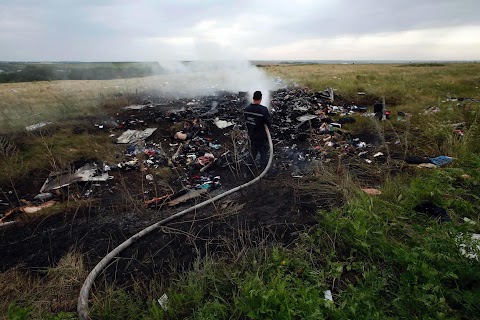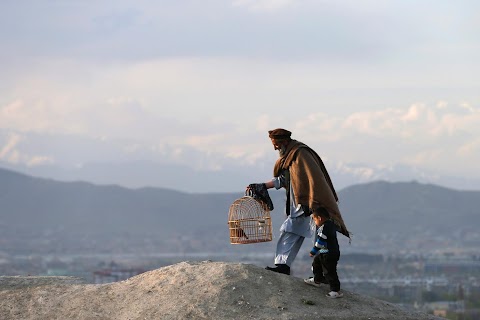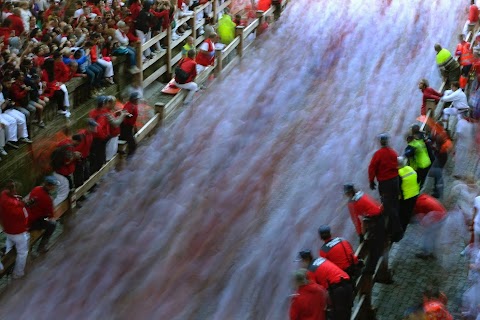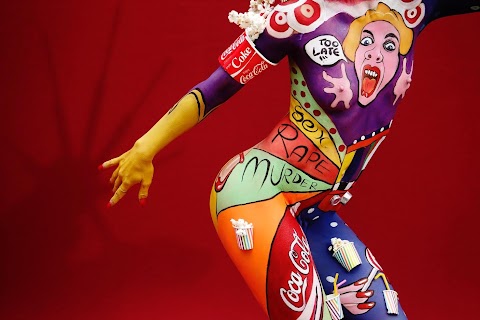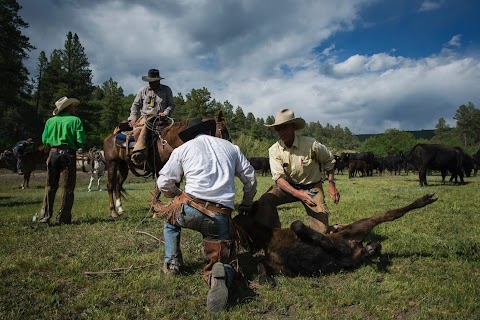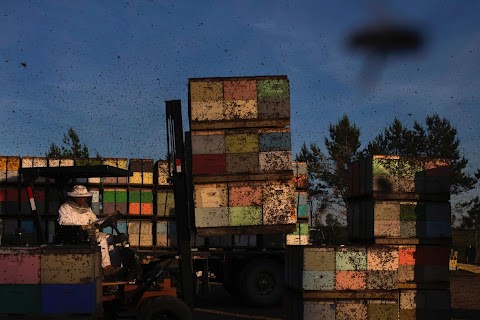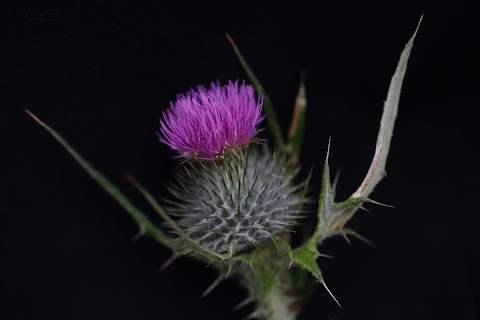
Details of Scotland
 Suzanne Plunkett
Suzanne Plunkett
Every nation has its symbols and Scotland is no exception. From the Scottish emblem of the thistle, to tartan fabric or Harris Tweed, all sorts of objects have come to be associated with the country.
Now, as Scots prepare to vote on September 18 on whether to end the 307-year union with England, photographer Suzanne Plunkett captured details of food, drink and other items seen as typically Scottish.

A handwritten manuscript by renowned Scottish poet Robert Burns entitled "The Death and Dying Words of Poor Maillie" is displayed at the Dick Institute in Kilmarnock.
Burns grew up near the town and his first book of poetry, "Poems Chiefly in the Scottish dialect," known as the Kilmarnock volume, was published there.
He is famously known for writing the words to “Auld Lang Syne” without which no New Years Eve party would be complete.

A busker's bagpipes are seen in the Scottish capital of Edinburgh.
The bagpipes’ distinctive sound is recognised worldwide and has found its way into popular music by the likes of Paul McCartney, Peter Gabriel, The White Stripes and Rod Stewart.

A Christmas figurine of the Loch Ness Monster – affectionately known as ‘Nessie’ – is displayed at a souvenir shop in Glasgow.
Nessie is the cuddly embodiment of a legendary beast supposed to live in the depths of a loch near Inverness.

Dolly the Sheep, the first cloned mammal ever created from an adult cell, is displayed at the National Museum of Scotland in Edinburgh.
Scientists Ian Wilmut and Keith Campbell of the Roslin Institute of Edinburgh, generated international headlines and intense ethical debates when they created Dolly in 1996.
The sheep, named after country singer Dolly Parton, was euthanised six years later after she was diagnosed with a progressive lung disease.

A bottle of Irn Bru is seen in Edinburgh.
The distinctive bright orange soft drink has been made since 1901 and its manufacturer, A.G. Barr, describes the soda as “Scotland’s ‘other’ national drink”.
Slideshow

A haggis is seen for sale at Pollok Williamson family butchers in Kilmarnock, Scotland. Traditional Scottish haggis is made from ground sheep’s heart, liver and lungs which is mixed with onion, oatmeal and seasonings and then stuffed into a sheep’s stomach.

Oatcakes, a kind of thin biscuits, are pictured in Edinburgh.

A glass of single malt whisky is seen in Edinburgh. Whisky, which is Gaelic for "water of life", has been distilled in Scotland for hundreds of years.

Cans of Tennent's Lager are displayed in a shop. First brewed in 1885, Tennent's is Scotland's best-selling larger brand according to owners C&C group.

A Tunnock's Tea Cake is seen in Edinburgh. Started in 1890, Tunnock's is one of the oldest family firms in Scotland. Their teacakes contain a puff marshmallow atop a biscuit covered in a layer of milk or dark chocolate.

A deep fried Mars bar is seen at the Golden Arrow fish, chips and chicken bar in Kilmarnock.

Tablet is displayed in a sweet shop in Edinburgh. Tablet is a grainy, crumbly sweet made from sugar, condensed milk and butter.

Sugar tops a stick of shortbread. Shortbread is a classic Scottish dessert made with flour, sugar, and butter.

The first gold coin minted in Scotland is displayed at the Hunterian Museum at Glasgow University.

Some of the Lewis Chessmen, which are made from walrus ivory and whales' teeth, are pictured on display at the National Museum of Scotland. Eleven of the ancient chess pieces, discovered on the Isle of Lewis in the Outer Hebrides, are kept at the National Museum of Scotland. Eighty-two are in the British Museum.

A sporran, a traditional part of male Scottish Highland dress, is seen at Kilts and Cashmere of Scotland in Glasgow.

Harris Tweed is displayed at the store. Harris Tweed is handmade in the Outer Hebrides. The traditional fabric, which has an Act of Parliament stipulating the conditions in which the cloth can be produced, frequently shows up on the catwalks of New York, Paris, Milan and London.

Royal Stewart tartan pattern kilts are displayed outside a shop along the Royal Mile in Edinburgh. It is considered traditional by some for men not to wear underwear underneath their kilts.

A St. Andrews souvenir golf ball is seen on a golf course in London. The Royal and Ancient Golf Club of St. Andrews is one of the world's oldest.

A branch of Scots Pine is seen in the Pinetum at Dean Castle Park in Kilmarnock. Recently chosen as Scotland's national tree, the Scots Pine or Pinus Sylvestris, features in the poems and songs of Robert Burns.

Gold ore mined at the Cononish gold mine is displayed in the Hunterian Museum at Glasgow University.

Scottish bank notes are displayed in London. Scotland's bank notes may look different to the English ones, but are legal tender throughout the United Kingdom.

A gargoyle on the Scott Monument, dedicated to author Walter Scott, is seen in Edinburgh.

Bricks forming a section of the Royal Mile are seen in Edinburgh. The cobbled street, which runs from Holyrood Palace to Edinburgh Castle, is the main artery of Edinburgh's Old Town District.
"Wait a second. There’s a thistle season?"
How hard can it be to find a thistle — the national emblem of Scotland — in Scotland?
Turns out it can be quite a prickly problem.
I needed a thistle to complete a set of close-up pictures I was shooting to try to capture the identity of Scotland in small details ahead of an independence referendum being held there on September 18.
The series was to include items such as tartan kilts, whisky, shortbread biscuits, Harris tweed and a lurid orange drink known as Irn Bru.
And, of course, a thistle.
Since I had a trip planned to Scotland, I could photograph many of these details in the country itself, but I thought I would get a head start and try to locate a thistle in London before I set off.
Having done my research, I dropped by my local florists and authoritatively requested Onopordum Acanthium — which as any scholar of botany (or person with access to the Internet) knows, is the Latin name for the Scotch Thistle.
The florist, without even pausing to look it up on her iPhone, archly responded that I should come back when they are in season.
Wait a second. There’s a thistle season?
Surely not in Scotland, I thought. I was sure I could find it in a posh Edinburgh flower shop. Surely they would have acres of greenhouses dedicated to growing the national flower year round.
Once in the Scottish capital I headed to Jenners, a famous department store with a renowned flower shop.
All they could offer me, however, was an ornamental thistle called Eryngium or Sea Holly.
Yes, it looked thistle-y, but it lacked the tufts of vibrant magenta colouring that you’d expect from the classic Scottish plant. I tried photographing it, but wasn’t satisfied. I could easily imagine the irate letters from proud Scots.
Back in London, I grabbed an assignment at the Chelsea Flower Show thinking that here, in this annual fiesta of flora I would surely be guaranteed at least one Onopordum Acanthium.
And there it was! Nestled in one of the ornamental gardens, I spotted a lovely magenta-topped plant surrounded by buzzing bees.
I snapped away and was about to head home when I paused to double-check with the garden’s designer.
“It is awfully close to the Onopordum Acanthium,” he said. “But no, it’s a Cirsium Trevors, shall I spell it?”
The designer said the thistle I needed would be in season and likely on show at the Hampton Court Flower Show a few weeks later — however I would be too busy covering the Wimbledon tennis championships to attend.
Deadlines loomed. A Cirsium Trevors looked awfully close. It fooled me, but tempting though it was to include a near-miss thistle, it would’ve been wrong.
I gave up. The project would have to go ahead without it.
Two weeks later, just before I was due to file my pictures, I was at friend’s house near Finsbury Park in north London. After lunch we decided to take a walk in the park.
As we took a shortcut through an overgrown path, I was about to casually tell my friend to mind the thorny plants when I realised what I was saying.
“Watch out for the THISTLE!?”
And there it was, bold as a bagpiper on Edinburgh’s Royal Mile. The Onopordum Acanthium in all its purple-tufted glory.
Of course, the moment I stopped looking, I saw them everywhere
I’m just thankful my list didn’t include Scotland’s national animal to my list — a unicorn.


